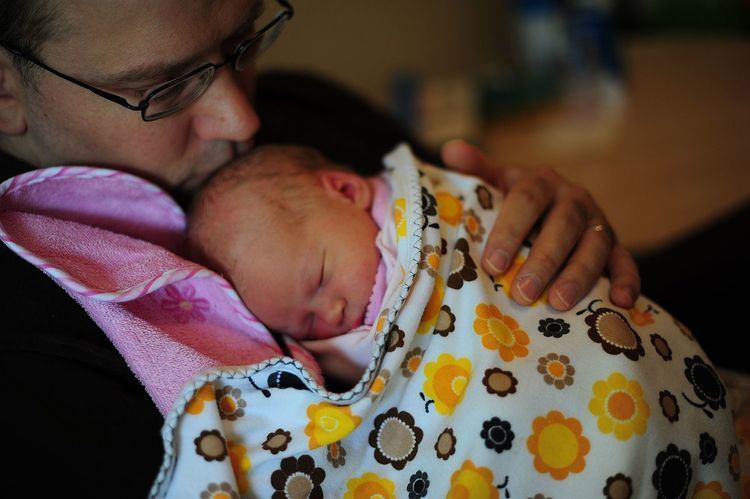 | ||
Similar Girl, Boy, Mother | ||
Definition of Father
A father is the male parent of a child. Besides the paternal bonds of a father to his children, the father may have a parental legal and social relationship with the child that carries with it certain rights and obligations, although this varies between jurisdictions. An adoptive father is a male who has become the child's parent through the legal process of adoption. A biological father is the male genetic contributor to the creation of the baby, through sexual intercourse or sperm donation. A biological father may have legal obligations to a child not raised by him, such as an obligation of monetary support. A putative father is a man whose biological relationship to a child is alleged but has not been established. A stepfather is a male who is the husband of a child's mother and they may form a family unit, but who generally does not have the legal rights and responsibilities of a parent in relation to the child.
Contents
- Definition of Father
- Paternal rights
- Role of the father
- Determination of parenthood
- History of fatherhood
- Canadian Fatherhood in the Interwar Era
- Fatheroffspring conflict
- Psychological manifestations in religion
- Biological fathers
- Non biological social and legal relationship
- Fatherhood defined by contact level
- Non human fatherhood
- References
The adjective "paternal" refers to a father and comparatively to "maternal" for a mother. The verb "to father" means to procreate or to sire a child from which also derives the noun "fathering". Biological fathers determine the sex of their child through a sperm cell which either contains an X chromosome (female), or Y chromosome (male). Related terms of endearment are dad (dada, daddy), papa, pappa, papasita, (pa, pap) and pop. A male role model that children can look up to is sometimes referred to as a father-figure.
Paternal rights
The paternity rights of a father with regard to his children differ widely from country to country often reflecting the level of involvement and roles expected by that society.
Parental leave is when a father takes time off to support his newly born or adopted baby. Paid paternity leave first began in Sweden in 1976, and is paid in more than half of European Union countries. In the case of male same-sex couples the law often makes no provision for either one or both fathers to take have paternity leave.
Fathers' rights movements such as Fathers 4 Justice argue that family courts are biased against fathers.
Child support is an ongoing periodic payment made by one parent to the other; it is normally paid by the parent who does not have custody.
An estimated 2% of British fathers experiences paternity fraud during a non-paternity event, bringing up a child they wrongly believe to be their biological offspring.
Role of the father
In almost all cultures fathers are regarded as secondary caregivers. This perception is slowly changing with more and more fathers becoming primary caregivers, while mothers go to work or in single parenting situations, male same-sex parenting couples.
In the West, the image of the married father as the primary wage-earner is changing. The social context of fatherhood plays an important part in the well-being of men and all their children. In the United States 16% of single parents were men as of 2013.
Involved fathers offer developmentally specific provisions to their children and are impacted themselves by doing so. Active father figures may play a role in reducing behavior and psychological problems in young adults. An increased amount of father–child involvement may help increase a child's social stability, educational achievement, and their potential to have a solid marriage as an adult. Their children may also be more curious about the world around them and develop greater problem solving skills. Children who were raised with fathers perceive themselves to be more cognitively and physically competent than their peers without a father. Mothers raising children together with a father reported less severe disputes with their child.
The father-figure is not always a child's biological father and some children will have a biological father as well as a step- or nurturing father. When a child is conceived through sperm donation, the donor will be the "biological father" of the child.
Fatherhood as legitimate identity can be dependent on domestic factors and behaviors. For example, a study of the relationship between fathers, their sons, and home computers found that the construction of fatherhood and masculinity required that fathers display computer expertise.
Determination of parenthood
Roman law defined fatherhood as "Mater semper certa; pater est quem nuptiae demonstrant" ("The [identity of the] mother is always certain; the father is whom the marriage vows indicate"). The recent emergence of accurate scientific testing, particularly DNA testing, has resulted in the family law relating to fatherhood experiencing rapid changes.
History of fatherhood
The link between sexual acts and procreation can be empirically identified, but is not immediately evident. Conception cannot be directly observed, whereas birth is obvious. The extended time between the two events makes it difficult to establish the link between them. It is theorised that some cultures have ignored that males impregnate females. Procreation was sometimes even considered to be an autonomous 'ability' of women: men were essential to ensure the survival and defence of the social group, but only women could enhance and reintegrate it through their ability to create new individuals. This gave women a role of primary and indisputable importance within their social groups.
This situation may have persisted throughout the Palaeolithic age. Some scholars assert that Venus figurines are evidence of this. During the transition to the Neolithic age, agriculture and cattle breeding became the core activities of a growing number of human communities. Breeding, in particular, is likely to have led women – who used to spend more time than men taking care of the cattle – to gradually discover the procreative effect of the sexual act between a male and a female.
For communities which looked at sexuality as simply a source of pleasure and an element of social cohesion, without any taboo character, this discovery must have led to some disruption. This would impact not only regulation of sexuality, but the whole political, social, and economic system. The shift in understanding would have necessarily taken a long time, but this would not have prevented the implications being relatively dramatic. Eventually, these implications led to the model of society which – in different times and shapes – was adopted by most human cultures.
Traditionally, caring for children is predominantly the domain of mothers, whereas fathers in many societies provide for the family as a whole. Since the 1950s, social scientists and feminists have increasingly challenged gender roles, including that of the male breadwinner. Policies are increasingly targeting fatherhood as a tool of changing gender relations.
Canadian Fatherhood in the Interwar Era
Fatherhood in Canada during the Interwar Period was a time of imposed change, led by state and expert advisement. A response to the impact of World War I on the male population, the Canadian government and citizens attempted to establish a “normalcy” of the family model which consisted of the stay-at-home mother and the breadwinner father as the ideal parental model. The challenge of this established normalcy was that few Canadians outside of the urban middle-class had ever seen this model in their households. Also, advice that was given to fathers at this time without sufficient recommendations on how to implement the standards of good fatherhood. Furthermore, expectations on fathers; and the actual practices of fathers were often different.
World War I's impact on fathers and fathers to be was devastating. Approximately 650,000 Canadian men served in the Armed Forces, and approximately 60,000 were killed, with another 60,000 bearing physical disabilities as a result of injuries. In this time period, very few programs or systems of support existed to help soldiers returning home. Because of this, many survivors of the War turned to drinking, distanced themselves from their families and lashed out at loved ones.
In response to this, government, academic and private institutions brought in experts in medicine, psychology, social work and education with the purpose of establishing a standard of good fathering. This advice was tailored to Anglo-Canadian working-class fathers, but was not written exclusively for them. According to these experts, a father was someone who was the main economic provider of the family, athletic, moral, devoted a portion of his time to his children and was a good husband to his wife. The expectation for fathers’ roles in the lives of their children was to be the authoritative figure of the household who showed love to his family by devoting the majority of his efforts to working and providing financially. A good father was also deemed to be someone who would bring other experts into the process of childrearing, including doctors, nurses, social workers and teachers.
Fathers were also expected to devote a period of time towards their children. Fathers were recommended to spend one hour per week with their sons. Most advice was directed towards the relationship between a father and his son, which encouraged temperance of a father’s response to questions and spending time with boys playing with and coaching them in sports. This amount of time was recognized to be short, but it was deemed better than not spending time with their children at all. Many labour organizations also argued for shorter work weeks as a means of increasing “family time,” for working-class fathers. Many fathers were unable to increase time spent with their children though due to long work days and work weeks.
Although expectations were high for fathers to be the breadwinners for their family, the economic nature of Canada and lack of support often led to differing results. The job market in the Great Depression often did not allow for fathers to provide for their families on a single income and receiving government assistance was seen as a 'personal failure' by many fathers. Since the identity of a father was so rooted in his ability to match the breadwinner model, the inability for a father to provide financially meant that many father's identities as successful members of the family were challenged. Also, although there was an expectation that fathers should be more gentle and temperate towards their children, fathers were often feared by their children.

Father–offspring conflict
In early human history there have been notable instances of father–offspring conflicts. For example:
In more contemporary history there have also been instances of father–offspring conflicts, such as:
Psychological manifestations in religion
Sigmund Freud suggested that God concepts are a projection of one's father. Among religions, many deities (typically the supreme or primordial ones) are referred to as "mother goddesses" and allfathers". In monotheistic religions, "God the Father" is one of the titles given to God.
Biological fathers
Non-biological (social and legal relationship)
Fatherhood defined by contact level
Non-human fatherhood
For some animals, it is the fathers who take care of the young.
Many species, though, display little or no paternal role in caring for offspring. The male leaves the female soon after mating and long before any offspring are born. It is the females who must do all the work of caring for the young.
Finally, in some species neither the father nor the mother provides any care.
